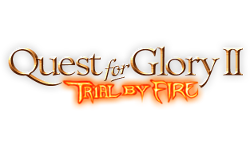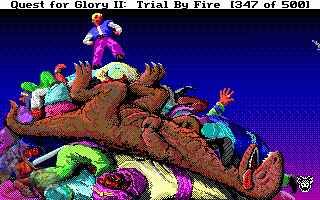|
|

|
PLATFORM
|
PC
|
BATTLE SYSTEM
|

|
INTERACTION
|

|
ORIGINALITY
|

|
STORY
|

|
MUSIC & SOUND
|

|
VISUALS
|

|
CHALLENGE
|
Moderate
|
COMPLETION TIME
|
Less than 20 Hours
|
|
OVERALL

|
+ Excellent writing, awful puns
+ Looks good in EGA
+ Multiple approaches to problem-solving
- Easy to get lost while in the city
- Some outdated hardware reliance issues.
|
Click here for scoring definitions
|
|
|
Some heroes slay the dragon, rescue the princess, and then rest on their laurels for happily ever after. Not so with the intrepid adventurer of Quest for Glory II: Trial by Fire. After saving the Barony of Spielburg from a witch's curse, our Hero is recruited for a whirlwind trip by flying carpet to distant Shapeir, a desert city of magic, mystery, and Marx Brothers jokes. Not all is well in the southern lands. Shapeir's sister city, Raseir, underwent a coup d'état the previous year, and the new Emir has enacted terrible new laws while driving out the mercantile Katta people. It's a pair of these friendly felines who have returned from the northern lands with a Hero to defeat the evil that plagues the desert.
No pressure, right?
Trial by Fire is organized a bit differently from its predecessor. This time around, the majority of the action takes place within city walls, and on a fairly set timetable. Over the course of the first nineteen days of game time, the Hero must fend off incursions by four mystic elementals, using his wits and tools to bend each of them to his will. In between these critical events, there's a lot of time for other things. Fighters can brave the monsters of the desert and join the Eternal Order of Fighters, and eventually gain the title of Paladin. Magic-Users can join the Institute of Technocery and gain the rank of Wizard. Thieves can take a few clandestine jobs from Dinarzad, the comely money-changer — or not, if the player decides to take the odd route and make the sneaky thief over into a Paladin as well. There's a tightrope act to challenge, a few mysteries to solve, and a warrior woman from far-off Fricana to challenge for some much-needed combat training.
Best of all, the Hero's Katta friends have given him free use of their inn, so he can rest whenever and for however long he desires. This gives the player much more control over the passage of time, as well as making it easier to jump ahead if things start to drag. There's also a magic map that provides instant transit to the major locations within the city of Shapeir, though the game makes the player work to get it. The very first real goal of the game is to find the money-changer in order to get the local currency and buy a map, and the narrow streets are not easily navigated without some skills at freehand cartography while playing.
 Ah, Dinarzad. You have such a way with words
Ah, Dinarzad. You have such a way with words
|
|
Combat has seen some definite improvements over the opening chapter of this Hero's saga. While it's still a matter of pressing the cursor buttons to attack, dodge, or defend, the point of view has shifted to make it more obvious how the Hero and the enemy are moving. Uhura's combat practice at the Guild of Adventurers is also a welcome means to work on skills without the constant threat of damage, and she gives good advice on how to recognize attack patterns as well. Battles still seem more akin to quick-time events than action-based RPG systems usually do, but there's a definite feeling of control over the situation that was lacking in the original game. Perhaps it's helped just as much by the cartoonish impact graphics whenever a hit is landed. In any case, fighting in this game feels better realized.
Unlike every other game in the series (including the first), Trial by Fire never received an official VGA release. Of course, that did not stop a group of fans from putting forward their own VGA adaptation in 2010 — a full twenty years after the original version hit the shelves. Even in the original EGA, this game is a visual treat, with plenty of little details and funny tricks for the player to spot. The presence of three Marx Brothers in minor roles is just the tip of the swordfish here. Ferocious battles, wondrous magic, and feline belly dancing are just a handful of things the player will witness before it's all done. In some ways, the limited color palettes actually help accentuate the cartoonish nature of the game, along with the expressive (if low-pixel) character sprites.
There's plenty of danger to be found as well, though regular practice with Uhura will make most battles a breeze by the end. Instead, there are far more prosaic ways to die, such as running out of water in the desert, as well as a few that require a devious mind to envision. Seriously, who would think to make it possible to overdose on healing pills?
 The squeaky floorboard gets the thief (in trouble).
The squeaky floorboard gets the thief (in trouble).
|
|
Two new stats have been added to the character sheet: Communication and Honor. The first increases as the player talks with NPCs about various topics, including such minor things as polite greetings and farewells. It pays to be courteous, as some characters will take offense if slighted, and the consequences are usually hilarious in their fatality. The main use for this stat is actually to bargain with shopkeepers for better prices on goods, with a variety of reactions based on whom one is haggling with.
The Honor stat is especially important if the player wishes to become a Paladin, but this path is lined with many conditions that reward roleplaying as lawful good. Naturally, there are several ways to dishonor oneself sufficiently that the path to paladinhood is completely blocked, including some otherwise quite viable strategies to solving a few quests. It's not impossible without an FAQ — or even with a Magic User or Thief as a protagonist — but it's definitely a challenge.
In fact, Trial by Fire is a bit unique in that the major side quests for each hero class are not actually exclusive. So long as the Hero has the basic skill required (possible if one drops all of the skill points into those spots at the start of this game and its predecessor), then it's possible to become a Wizard, join the Eternal Order of Fighters, and take all of the burglary jobs in a single run. Then again, all of this provides an excellent reason to play through the game more times and in different ways.
 This is how you hero!
This is how you hero!
|
|
The music is technically made of the same tunes as the first game, but most of the tracks have been given an Arabian Nights makeover. While the streets of Shapeir are still eerily quiet, on average there's less dead air in this game than its predecessor. Many areas have small amounts of atmospheric background music going on, and there are some good event themes as well. It's an improvement, even though it's bound by the restrictions of its intended hardware.
That's really the only complaint that can be brought against this game. It's a quarter of a century old, even if it looks good as it is. The feature to import a character from the previous game and then pass it along to the next — a major plus, not to mention a rarity in its time — is hampered by the modern lack of A: drives in computers. There are ways around it, but it's still an annoyance. Also, for whatever reason these games will not acknowledge one of the Shift buttons on my old laptop, which is why my Hero's name shall forever be left uncapitalized.
While it's not as open an experience as the first game, Trial by Fire makes up for it with a strong narrative, superb writing, and a graphical design that really works the EGA chip to the fullest. This is one old game that's certainly no ordeal.
AOI.
(Kudos to anyone who knows what the above line references. No cheating!)
Review Archives
|









